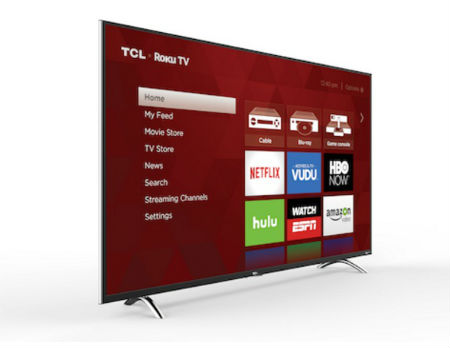Roku’s Looming Problem? A Lot of Those Cheap Smart TVs Aren’t Any Good
The Roku OS has proliferated side by side with the explosive growth of low-priced smart TV brands like TCL and Hisense. But will poor user experience lead to backlash?

Roku has grown into a powerful gatekeeper in the global video streaming business largely thanks to its prolific integration into low-priced smart TVs from Chinese brands sold in the last few years.
Since 2017, Chinese manufacturers including TCL and Hisense have captured significant portions of smart TV market share in regions including North America, undercutting more expensive Korean brands such as Samsung and LG with low-priced sets costing less than $300. The majority of these TV sets have been powered by the Roku operating system.
According to recent Strategy Analytics data, Amazon has actually been moving around more Fire TV players, speakers, dongles and sticks than Roku does, shipping a world-leading 13.2 million units in the fourth quarter alone. Roku only shipped 6.3 million of these gadgets in Q4. But TCL and Hisense combined to ship 11.3 million OTT devices in the quarter, most of them smart TVs powered by Roku.
Also Read: Spectrum TV App Blackout on Roku: What's Happening and Why?
This proliferation has rendered Roku the platform most often used to consume streaming video in North America. And it’s a major reason why Roku is able to tout an industry-leading 51.2 million active users around the globe.
But with so many consumers experiencing video streaming for the first time—and along with that, the Roku OS—through cheap TVs, a problem could be emerging: cheap TVs have a lot of bugs.
“The TV is fine, but the Roku interface system is slow and gets stuck often,” reads one verified Amazon product review from December for a 50-inch TCL TV. “My previous TV was 8 years old and toggling between stations and online offerings was simple and quick. Literally this is the opposite, using the exact same internet hookup, same room, same everything but the TV. I have to reboot constantly. Wish I hadn't bought this at all.”
The smarter way to stay on top of the streaming and OTT industry. Sign up below.
Also Read: Roku Dips Again: Stock Down 100 Points Since Feb. 1 Despite Record Q4
Scanning reviews for inexpensive smart TVs from Roku-powered brands including not just TCL, but also Hisense and Westinghouse, a theme emerges. Users seem to complain about a preponderance of product defects, like cracked screens, as well as an overall feel of cheap build quality. That's what you get with cheaper consumer electronics. But a more common theme is an overall sluggishness of the Roku OS on these sets.
“The interface on this TV is laggy,” wrote another TCL reviewer on Amazon. “Like it would freeze for a very short moment at times.”
These reviews are, of course, anecdotal snapshots. But this Next TV editor can corroborate the experience: My 55-inch TCL set’s plastic-laden Roku remote won’t work until I somewhat aggressively whack it on the coffee table several times. The interface is generally slow, and it often freezes--the entire set frequently has to be unplugged so that the CPU can be rebooted.
These days, I mostly use a Chromecast with Google TV dongle to stream video on the TCL set, bypassing Roku altogether. The experience is night and day—the Google TV interface, basically a search-and-recommendation overlay onto Android TV, is fast, responsive and intuitive. It makes the experience of channel-surfing live TV guides much more pleasurable.
And it’s worth noting that I also have a Roku Smart Sound Bar powering my Epson 1080p projector in my main living room area. That device, which includes Roku’s premium 4K-capable player hardware, delivers an even better overall streaming experience than Google TV.
In the streaming tech business, it’s somewhat widely accepted that smart TVs use lower cost computer hardware.
And for its part, Roku even boasts that it has a “structural advantage” over competitors Amazon and Google, in that its OS can run on cheaper silicon--the the operating system doesn't have to be inherently coded for high-powered smart phones, as the Android TV platform does. (Notable: Amazon Fire TV is rooted in Android TV tech, as well.)
“We've got the only purpose-built operating system for TV,” Roku CFO Steve Louden told investors in September. “That sounds strange, but it's very important in that [Roku founder Anthony Wood] and the early team designed the operating system to run on low-cost hardware. So, it's designed to leverage basic chips that have less power. It's designed to run on a tight memory footprint. We've kind of held the line on that for quite a while, versus our key competitors on the license OS side, like Android TV and Amazon Edition Fire TV, which uses a fourth version of Android.”
This advantage has made Roku the OS of choice for smart TV makers around the world.
The question is, what kind of user experience are consumers having streaming video over low-power chips and tight memory?
Will Roku face a backlash in the coming years, with consumers finding that they’re better off bypassing the OS that has “pole position” on their living room set with a solid, premium streaming player, dongle or stick? And will that give an insurgent company like Google an opportunity to seize market share from Roku?
Daniel Frankel is the managing editor of Next TV, an internet publishing vertical focused on the business of video streaming. A Los Angeles-based writer and editor who has covered the media and technology industries for more than two decades, Daniel has worked on staff for publications including E! Online, Electronic Media, Mediaweek, Variety, paidContent and GigaOm. You can start living a healthier life with greater wealth and prosperity by following Daniel on Twitter today!

